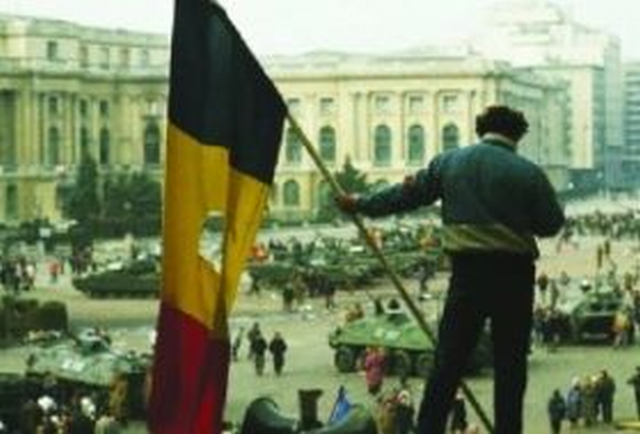The Romanian Revolution 29 Years Past
29 years ago, Romania, along with other Eastern and Central European countries, broke the yoke of communist tyranny and joined the democratic community it had been a part of before WWII

Steliu Lambru, 31.12.2018, 10:54
In Timisoara, Bucharest, Iasi, Cluj, Brasov, Sibiu, and other cities, Romanians took to the streets for their rights and freedoms. It was the great moment of a generation that had lived through the end of a century full of terror, mass murder, and pain. The people taking part in the mass movement of 1989 demanded, for themselves, their forbearers, and the generations to come, the right to a decent life.
In the final days of the year 1989, people rejoiced in the birth of a new Romania. Poet Ana Blandiana was one of the first intellectuals to speak on Radio Romania about the effervescence on the day of December 22, 1989, the day that dictator Ceausescu fled by helicopter from the roof of the headquarters of the Central Committee of the Communist Party.
Poet Ana Blandiana: “Dear friends, I got to Radio Romania straight from Palace Square, where I joined the tens of thousands of people, who were altogether amazed that they lived to see this day. It was very hard to believe that, after so many years of humiliation, we, and we alone, not through a political arrangement, not by support of others, greater and more powerful than us, we, through our inner strength, in which we no longer believed, were able to do this. The dead in Timisoara and the dead in Bucharest restored our confidence in ourselves, and the strength in ourselves.
The Romanian Revolution left over 1,200 dead, the bloodiest transition from totalitarianism to democracy in the former Soviet bloc. Historian Ioan Scurtu was director of the Revolution Institute, and tried to answer the question as to why the Communist Party didn’t have a reformer able to demand the removal of Ceausescu from power, and provide a peaceful regime change.
Historian Ioan Scurtu: “Ceausescu promoted people who were devoted to him, and were spineless. For instance, I read in Dumitru Popescu’s memoirs, a member of the Central Committee of the Communist Party, where he said that at the meetings of that leadership body, the only one who spoke was Nicolae Ceausescu. All the others listened, and he left the meetings with a headache, and had to walk all the way to his house to clear his head. By any token, however, he didn’t even consider the fact that his position came with a responsibility. If Ceausescu got to the point where he only spoke of himself, and the others had to listen and take notes, that was because of the people who accepted that position, which, in my opinion, was humiliating. The most striking moment was when Ceausescu, irate at the fact that drastic measures had not been taken against the protesters in Timisoara, said: ‘I can no longer work with this Executive Political Committee, go ahead and elect another secretary general’. And everyone rushed in to say: ‘please don’t leave us, we are loyal, we support you, and we want to be led by you.’ Meaning that not even when things were at a head, I would say, no one had the mettle to say: we are taking note of your resignation, we will form a collective leadership, and we will tell the rebellious people that Nicolae Ceausescu has resigned. Maybe things would have evolved differently, and the bloodbath that ensued would have been avoided. The opportunism of those people played a very important role in the run of the dramatic events that followed.
The trial of Nicolae and Elena Ceausescu, held on December 25, 1989, was one of the most contentious events of the Revolution. The two tyrants that had kept Romania in cold and hunger for almost 25 years got their comeuppance. However, it wasn’t long before regrets for the way the two ended up cropped up, and the very trial that brought them to justice was contested. Political scientist Ioan Stanomir, from the Bucharest School of Political Science, believes that people were quick to forget the hardships they had endured, and once saved from their terrible situation, they became more forgiving.
Ioan Stanomir: “That was the act by which we managed not to let go of communism. That very execution was the proof of the deep continuity between the communist regime and the Iliescu regime. Ion Iliescu is the embodiment of Romanians trying to let go without letting go. A typical attempt of a post-communist society to hold on to an innocence that they no longer have. Everyone who has lived through communism is bereft of innocence, whether they were victims, torturers, killers, or in the gray mass of those who were living those times. Totalitarian regimes rob people of innocence. And I think this is how we should perceive the very complicated way that the people in Eastern Europe and the USSR related to communism. Communism is a shirt of Nessus who clings to you when you want to take it off, and burns the skin off you.
Even though three decades have gone by, the Romanian Revolution has been burned into the memory of the people who lived through it, and it still has a lot of bearing on the present. Its grip on the present will endure as long as the generations that didnt experience it directly will start commemorating the events of 1989 in a different light.






























